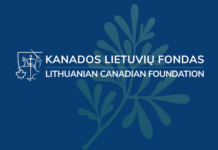
Also called Mardi gras, Carnaval or Shrove Tuesday
Užgavėnės is a traditional festival that takes place during the seventh week before Easter, the day before Ash Wednesday, the beginning of Lent. The word literally means “the time before Lent” and is related to the verb “užsigavėti”, which refers to the tradition of eating a lot of fatty food before Lenten fasting. Užgavėnės begins on the night before Ash Wednesday, when an effigy of winter (usually named Morė) is burnt. Morė is one of the main effigies and attributes of this traditional Lithuanian folk festival. It is an artificial woman (čiūčiala – some may remember being taunted with this name if your hair was messy). She is associated with the winter personification of the Slavic goddess Marzanna. She is burned because once it was believed that it will help to bring spring more quickly. Participants of the ritual dance around the bonfire and shout “Žiema, žiema, bėk iš kiemo” (Winter, winter, run from the yard).

A major element of the holiday, meant to symbolize the defeat of winter, is a staged battle between Lašininis (“porky”) personifying winter and Kanapinis (“hemp man”) personifying spring. Devils, witches, goats, the grim reaper, gypsies, and other joyful and frightening characters appear in costumes during the celebrations. The participants and masqueraders dance and eat the traditional dish of the holiday – pancakes with a variety of toppings, as well as donuts (spurgos).
The tradition of Užgavėnės harks back to ancient times, and is particularly popular in Vilnius. It is a cheerful event, meant to ward off or mock evil, to awaken the earth, visit neighbours and eat huge amounts of food, whether pancakes or fatty meats or donuts. Lithuanians from the southwest of Lithuania, or Lithuania Minor, who were mostly Lutheran, also traditionally celebrate the beginning of Lent with a šiupinys, a stew of beans and pigs’ ears.
The oldest Užgavėnės tradition is to dress in costume and visit neighbours. At first the masks used were images of ancestors and mythological creatures, devils, skeletons and witches, as well as animal totems. Later the images began to include “foreigners”, Gypsies, Jews, Hungarians and Germans – not as a mockery but more to emphasize the spirit of the “unknown”. At present, the trend is more toward making fun of negative events and entities, for example, politicans…

The most important mission of the festival is to chase away winter and invite spring, to awaken the earth for a new cycle of life, bringing in fertility and harvest rituals. Bachelors and spinsters were often made fun of, and the festival was also an opportunity to find a mate. In olden days, it was a time to spring clean, and the Morė straw effigy was dressed with old rags and bits of trash to be burned and thrown away. Her execution symbolizes the victory of spring against winter.

Although the day itself is not a religious holiday, the custom was to do no work around the homestead. As on many other occasions, the weather on the day of Užgavėnės was used to prognosticate the weather in the coming spring and the success of harvest. Over the years, holding a farmer’s market also became part of the festival.
This year, although Pancake Tuesday falls on February 16, the Vilnius Ethnic Cultural centre is organizing the festival and market in the capital city on February 25.
A display of folk art masks by Karolis Gediminas Cieminis (1943–2014) is available on the website of the National Museum of Lithuania



























